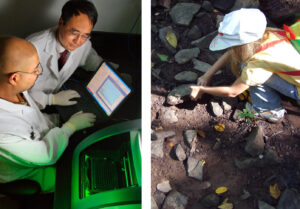You might imagine that scientific thinking differs from the sorts of reasoning tools that you use in your everyday life — that scientists go around with a head full of equations through which they view the world. In fact, many aspects of scientific thinking are just extensions of the way you probably think everyday:
- Ever seen something surprising and tried to figure out how it happened? Perhaps you’ve seen a magician make his assistant disappear from a box and wondered if the trick involved a trap door ….
- Ever sought out more evidence (e.g., by looking for a joint in the floor beneath the box)?
- Ever come up with a new explanation for a mystery? Perhaps the trick used a mirror to reflect an image of an empty wall ….
These might seem like trivial examples, but in fact, they represent scientific habits of mind applied to an everyday situation. Scientists use such ways of thinking to scrutinize their topics of study — whether that’s human behavior or neutron stars — and you can use the same tools in your own life.

Want to develop your scientific outlook? Try to consciously apply these habits of mind to the natural world around you:
- Question what you observe. How does bleach lighten your clothes? How do bees find their way back to the hive? What causes the phases of the moon?
- Investigate further. Find out what is already known about your observations. Your sister says that bleach washes chemicals out of fabric, while your chemistry book says that bleach is good at breaking molecular bonds that cause chemicals to appear colored.
- Be skeptical. You’ve heard that honeybees use the sun to navigate, but does that really make sense? What would they do on cloudy days?
- Try to refute your own ideas. Look at things from the other side of the argument. You’d always assumed that the phases of the moon were caused by the shadow of the Earth falling on the moon — but if that were really the case, then how is it that we can sometimes see both the moon and the sun in the sky overhead?
- Seek out more evidence. Does bleach work better on some sorts of stains than others? Do bees leave the hive on cloudy days? Is there any relationship between the phase of the moon and where it appears in the night sky?
- Be open-minded. Change your mind if the evidence warrants it. If everything you learn about the moon clashes with the idea of lunar phases being caused by the Earth’s shadow, perhaps you should give up that idea and look for other explanations.
- Think creatively. Try to come up with alternate explanations for what you observe. Maybe bees also use landmarks to get back to their hives, maybe they use the Earth’s magnetic field, maybe they follow some sort of scent trail, or maybe they use a combination of navigation methods …
In terms of answering your original questions, some of these strategies are bound to be dead ends. At the end of the day, you’ll have learned a lot but may still be without solid answers. And if so, congratulations — you’re really thinking like a scientist! Scientific investigations, like your own exploration, often lead in unexpected directions and lack tidy endpoints. Nevertheless, these ways of thinking illuminate the world around us in ways that are often useful and always fascinating, revealing the inner workings of our everyday experiences — whether that’s a walk past a garden, a moonlit night, or just doing a load of laundry.
Taking a scientific outlook on life makes the world an interesting place — but on a more practical level, you can also use scientific knowledge and ways of thinking to make informed decisions. To learn more, visit Getting personal in our section on the applications of science.
You can help your students appreciate the excitement of scientific discoveries in many ways — for example, by discussing science news stories, new and compelling research, or the announcement of the Nobel prizes in science. Most importantly, you should model the excitement and curiosity for science that you want to inspire in your students. One way to do this is to take time to legitimately engage student questions about science topics, even if they stray somewhat from the designated content. After all, scientists do not limit their curiosity to topics narrowly defined by their previous work.
